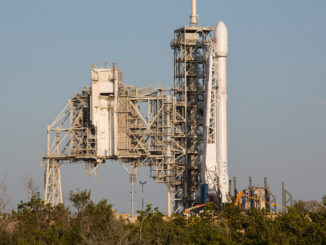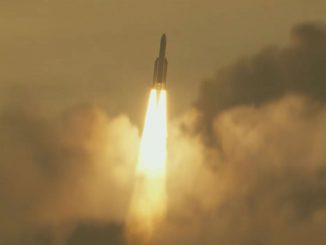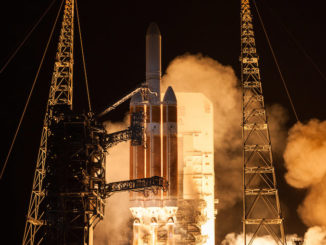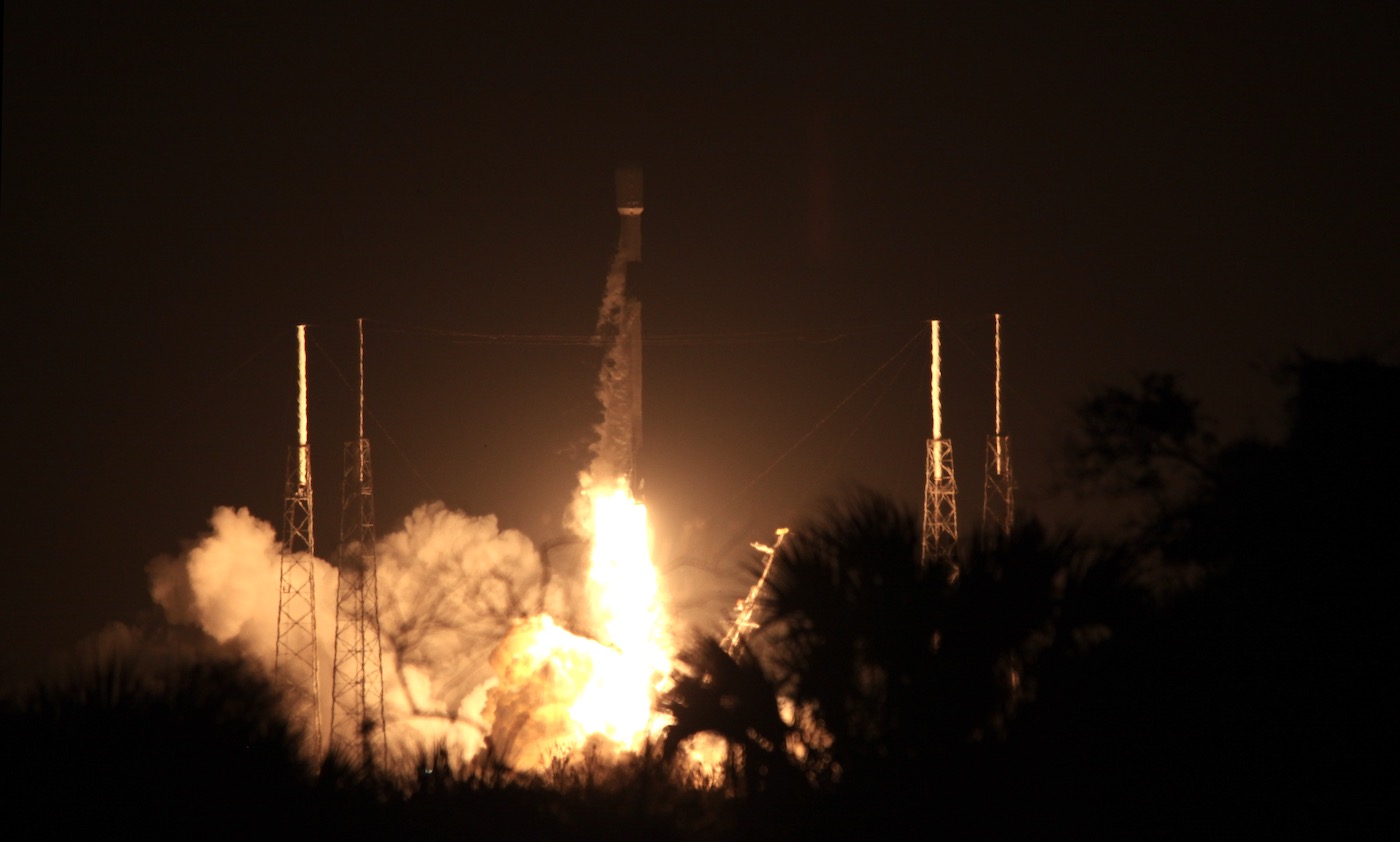
SpaceX successfully launched 60 more Starlink internet satellites Monday night from Cape Canaveral, but lost the Falcon 9 rocket’s reusable first stage booster during a landing attempt on a drone ship parked in the Atlantic Ocean.
The 229-foot-tall (70-meter) Falcon 9 rocket blasted off at 10:59:37 p.m. EST Monday (0359:37 GMT Tuesday) from pad 40 at Cape Canaveral Space Force Station, a day after weather kept the mission on Earth.
Heading northeast with 1.7 million pounds of thrust from nine Merlin main engines, the kerosene-fueled rocket fired into a clear late-night sky over Florida’s Space Coast on SpaceX’s fifth Falcon 9 launch of the year.
The first stage finished its job two-and-a-half minutes after liftoff, and dropped away moments before the Falcon 9 ignited its single-engine second to stage to deliver the 60 flat-panel Starlink satellites into orbit.
The booster extended grid fins and arced downrange on a ballistic trajectory, then oriented for the plunge back into the atmosphere. The first stage was programmed to fire three of its nine Merlin engines for an entry burn, then reignite a single engine for a final braking maneuver just before attempting a propulsive landing on SpaceX’s drone ship “Of Course I Still Love You” positioned roughly 400 miles (630 kilometers) downrange from Cape Canaveral.
But something appeared to go wrong with the entry burn. A live video feed from an on-board camera showed the rocket trailing a fiery plume after the end of the entry burn, moments before telemetry data from the vehicle cut off. A camera from SpaceX’s drone ship showed an orange glow in the sky as the rocket presumably crashed into the Atlantic.
The booster flown on Monday’s mission — designated B1059 — was on its sixth trip to space. SpaceX says the most recent version of the Falcon 9 booster can make 10 flights with only inspections and minor refurbishment in between missions, and can fly on additional launches after a major overhaul.
There was an unusual signature at the end of the Falcon 9 booster’s entry burn tonight, followed seconds later by the end of telemetry from the rocket.
The booster crashed in the Atlantic Ocean near SpaceX’s drone ship.https://t.co/iSV3bbx5ro pic.twitter.com/HqY06KmxiL
— Spaceflight Now (@SpaceflightNow) February 16, 2021
SpaceX’s most-used Falcon 9 booster has flown eight times.
The company’s recovery and reuse of Falcon 9 first stages is unparalleled in the launch industry. No other commercial launch company has landed and reused boosters on orbital-class missions. Going into Monday night’s launch, SpaceX had recovered Falcon booster cores 74 times since 2015, including 24 straight successful landings since the last time the company lost a first stage in March 2020.
The loss of a rocket stage will almost certainly garner an investigation at SpaceX, and could impact the company’s near-term launch schedule. SpaceX has six Falcon 9 boosters left in its inventory. Three of those are earmarked for future missions for NASA and the U.S. Space Force: SpaceX’s next crew launch to the International Space Station in April, and launches with a GPS satellite and NASA asteroid probe in July.
SpaceX is building more Falcon cores, including boosters for the next triple-body Falcon Heavy launch later this year, but none are on the cusp of reaching the launch pad.
While the once-experimental rocket landings are a secondary objective on each mission, the successful recovery of Falcon boosters is more critical than ever for SpaceX’s ability to maintain its high-tempo launch cadence, especially for flights adding to the company’s Starlink internet network. The launch Monday night was SpaceX’s third in less than a month dedicated to the multibillion-dollar Starlink program, and officials planned two more Starlink missions before the end of February.
Before Monday night’s launch, SpaceX planned the next Falcon 9 flight — using a different first stage booster — from pad 39A at the Kennedy Space Center as soon as 12:55 a.m. EST (0555 GMT) Wednesday. It was not immediately clear how the booster’s failed landing might impact those plans.
SpaceX officials did not provide any details on why the booster failed to land on the drone ship Monday night. The second stage accomplished the primary goal of the flight, and used two burns of its Merlin-Vacuum, or MVAC, engine to inject the 60 Starlink satellites into an on-target orbit less than 200 miles (300 kilometers) above Earth.
SpaceX lost the Falcon 9 booster on descent.
A brief flash from the rocket’s landing burn was visible in a camera view from the drone ship.
This was the 6th flight of this reusable booster.
The upper stage is safely in orbit with 60 Starlink payloads.https://t.co/iSV3bbx5ro pic.twitter.com/Z76zdXuyQq
— Spaceflight Now (@SpaceflightNow) February 16, 2021
“We were not able to land the first stage, which is a bummer, but our second stage did have two successful burns of the MVAC engine,” said Jessie Anderson, a SpaceX engineer who hosted the company’s launch webcast Monday night.
The upper stage spun itself up for release of the 60 Starlink satellites a little more than an hour after liftoff. The quarter-ton satellites, built by SpaceX in Redmond, Washington, flew free of the Falcon 9’s second stage before commencing automated activation procedures to unfurl their solar arrays and begin standard post-launch checkouts.
The satellites will turn on their krypton ion thrusters to climb into their operational orbit 341 miles (550 kilometers) in altitude, with an inclination of 53 degrees to the equator.
SpaceX has more than 1,000 satellites in its Starlink constellation, well on the way to finish deployment of its initial tranche of 1,584 Starlink stations later this year. SpaceX won’t stop there, with plans to launch additional orbital “shells” of Starlink satellites into polar orbit to enable global coverage, with a first-generation fleet totaling some 4,400 spacecraft.
The Federal Communications Commission has authorized SpaceX to eventually operate up to 12,000 Starlink satellites.
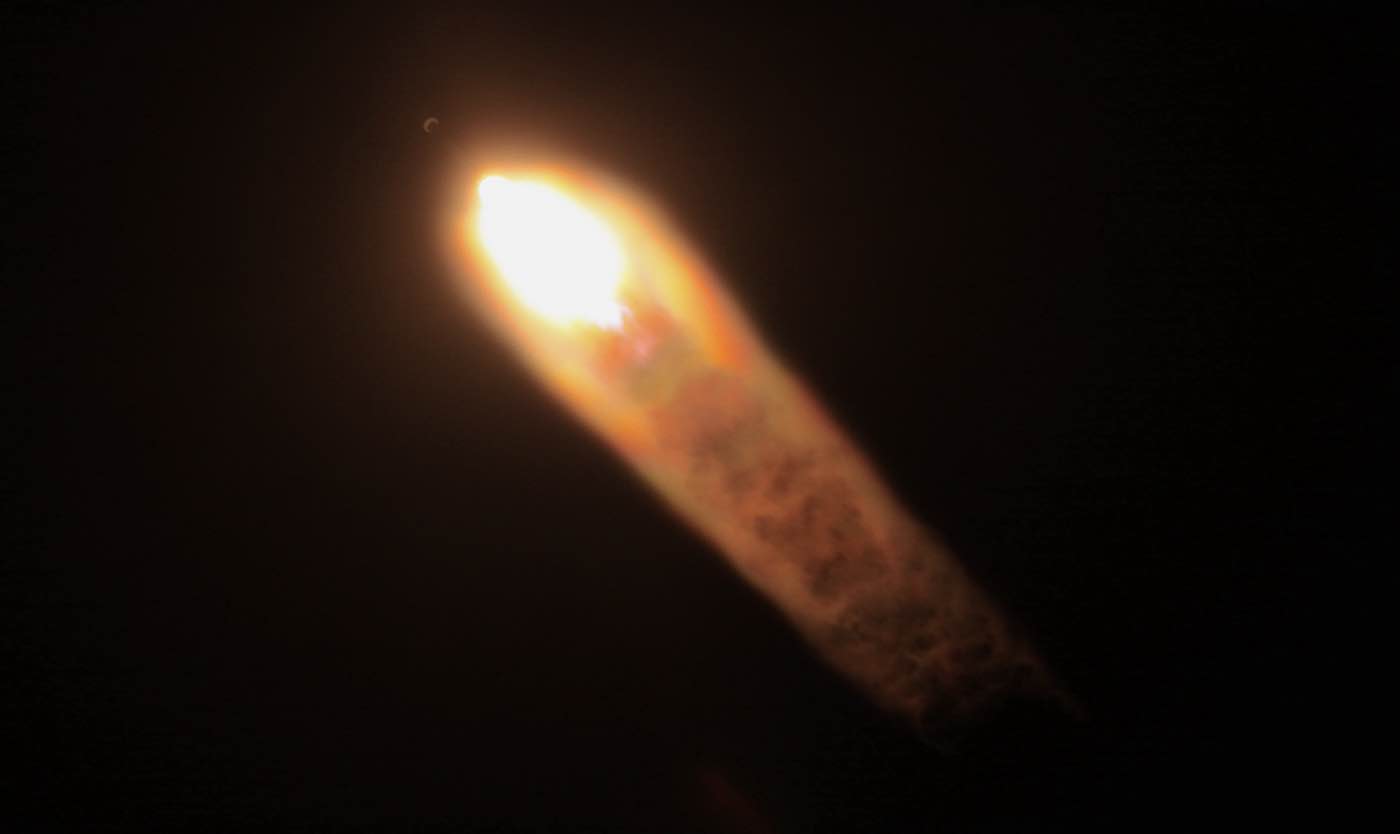
SpaceX began accepting preorders from would-be Starlink users last week, charging $99 for a potential customer to get in line for the broadband service. Once confirmed, customers will pay $499 for a Starlink antenna and modem, plus $50 in shipping and handling, SpaceX says. A subscription will run $99 per month.
SpaceX says the service should be available throughout the United States later this year.
Beta testing of the Starlink network has been underway for months in the northern United States, Canada. SpaceX said more than 10,000 users in the United States are abroad are already on the Starlink service, according to a Feb. 3 regularly filing with the FCC.
“Starlink continues to improve as SpaceX deploys additional infrastructure and capability, averaging two Starlink launches per month, to add significant on-orbit capacity alongside activation of additional gateways to improve performance and expand service coverage areas across the country,” SpaceX wrote in the filing.
Elon Musk, SpaceX’s founder and CEO, tweeted Feb. 9 that SpaceX’s Starlink subsidiary will go public once it has a predictable cash flow.
“Once we can predict cash flow reasonably well, Starlink will IPO,” Musk tweeted.
Until then, SpaceX will be spending cash at a high rate to maintain the Starlink network’s high-tempo deployment, from satellite launches at an average pace of every couple of weeks to the manufacturing of user ground terminals. SpaceX has said the entire project could cost more than $10 billion, but Musk has said the revenue opportunities are even higher, providing resources for SpaceX to advance its audacious plans to send people to Mars.
SpaceX confirms the 60 Starlink broadband satellites successfully deployed from the Falcon 9 rocket’s upper stage in orbit. This brings the total number of Starlinks launched to 1,145 satellites.https://t.co/iSV3bbx5ro pic.twitter.com/8GkPqSk5h1
— Spaceflight Now (@SpaceflightNow) February 16, 2021
“SpaceX needs to pass through a deep chasm of negative cash flow over the next year or so to make Starlink financially viable,” Musk tweeted. “Every new satellite constellation in history has gone bankrupt. We hope to be the first that does not.”
The FCC awarded SpaceX nearly $885 million in government subsidies in December through a program aimed at expanding broadband access for rural Americans.
Email the author.
Follow Stephen Clark on Twitter: @StephenClark1.

